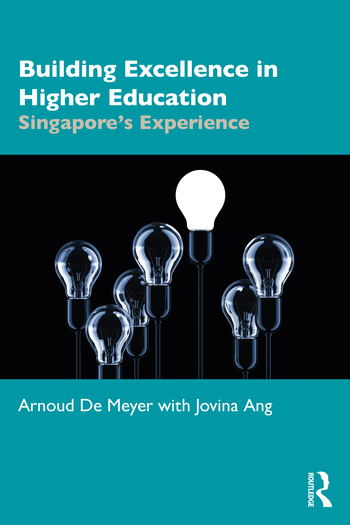Building excellence in Singapore’s higher education – past, present and future

Singapore’s higher education system may seem to have always punched above its weight for quality teaching, research and innovation. But it has achieved in a mere three or so decades what other countries have taken centuries to develop.
According to Professor Arnoud De Meyer's new book, Building Excellence in Higher Education: The Singapore Experience, Singapore in the 1980s had experienced high unemployment, and was considered a third-world country and a labour-intensive manufacturing economy with few professionals.
By 2018, a fifth of its population was in manufacturing roles. In 1981, it spent S$0.9 billion on education and increased this to S$13.1 billion in 2018, about four percent of Singapore’s gross domestic product. There were about 3,000 university graduates in 1980 compared with 19,000 in 2019.
Now about four-in-10 Singaporeans partake in higher education and it is economically a first-world country. As well, the country’s higher education transformation successfully navigated three economic recessions in the late 1980s, 1997 and 2008.
Today, this island nation has 34 universities – six of them national – packed into a tiny 709sqkm. That land area is about 3.5 times bigger than Washington DC. And that’s a useful comparison, because an exemplary institution, the National University of Singapore (NUS), revamped to combine the rigour and depth of the British higher education system with the flexibility and breadth of the US system. Now, NUS sits at 21st in the World University Rankings for 2022 and third for the Asian University Rankings last year, according to the Times Higher Education rankings. Meanwhile, Nanyang Technological University ranks 33rd in the Best Global Universities. These two universities also rank in the globe’s top 70 for scientific impact. SMU is ranked 14th amongst specialist universities in the world.
The sector did not take a ‘cookie-cutter’ but a strategic approach to transformation. So, what’s behind this success?
Someone with deep insights into the sector’s transformation is Prof De Meyer, whose book Building Excellence in Higher Education: The Singapore Experience was written with Jovina Ang and has just been published by Routledge.
Prof De Meyer offers substantially more than a ‘fly on the wall’ or academic perspective in Singapore’s higher education transformation. Apart from interviewing more than 30 decision-makers and higher education and research leaders, he has played a role as the former President of Singapore Management University and Lee Kong Chian School of Business Professor Emeritus. As well, Prof De Meyer has held leading roles at the University of Cambridge in the UK and was the founding Dean of INSEAD in Asia. This is his 10th book, and it focuses on the role of six highly differentiated and diversified national universities in transforming the country’s higher education system.
Prof De Meyer explains that Singapore’s higher education sector addresses two critical needs: First, to develop skilled human capital to build the nation and its economy and second, to fulfil citizens’ aspirations to achieve their full potential through tertiary education.
Keys to success
Singapore built its higher-education powerhouse from a low base with the help of a national narrative to build a new economy.
When it declared its independence from Malaysia in 1965, the nation had just two universities and two polytechnics. This was – and is – a country with only its people and location as the predominant resources. Within three decades after independence, the whole-of-country efforts to build a knowledge economy began in earnest. This blueprint involved elements such as a fit-for-purpose system, significant governmental financial investment in the sector, good governance, and a search beyond its borders for expertise to build partnerships and collaboration as well as ensuring flexible implementation, according to Prof De Meyer.
These factors all played a part:
- Lifting the pension age from 55 to currently a retirement and re-employment age of 65 to 70
- A 1995 government task force set up with the goal of Singapore being home to the Harvard or MIT of Asia
- An initial focus on science and engineering, in line with the country’s economic development and industrial needs
- Establishing Singapore as a key education hub, attracting partnerships with foreign universities and building a strong alumni community
- Nurturing a healthy R&D environment that saw top researchers, including those from overseas, mentor the new generation of researchers
The government restructuring top public universities to ensure they have high autonomy, balanced with accountability, and the launch of the SkillsFuture movement to add a continuing education and training strength to the sector, thanks to a 2015 government initiative.
On a human capital level, Prof De Meyer stressed the importance of changing staff mindsets. It marked a shift from the bureaucratic to a more resourceful, entrepreneurial, innovative and pioneering disposition. Singapore made this happen by converting from a civil-service pay scale to one based on performance and market-based evaluation and remuneration systems.
The multipronged efforts have coalesced into a higher education that is now fit for purpose and well aligned with the country’s overall education system and economic development goals. It is a holistic approach to education that places universities along the continuum of lifelong and continuing skills learning.
Future challenges
Singapore’s higher education system cannot coast on its success. There are three future challenges in the international sphere, says Prof De Meyer:
- The need to improve how the sector’s research translates into innovation and technology for the country’s industry and services, such as through industry intermediaries
- Technology’s role in higher education learning and research, particularly the ability of curricula’s response to rapid digitalisation and continuing globalisation, and
- Continuing Singapore’s integrated ‘whole-of-government’ approach with SkillsFuture at the vanguard. In this, he urges universities to capitalise on the opportunity to offer continuing education and training (CET) as their role in fostering lifelong learning.
With the latter, Prof De Meyer suggests Singapore is well-placed to preserve its competitive position and offer thought leadership in adult education. But it must be clearer on the role Singapore’s universities play in lifelong learning.
On a more granular level, the challenges specific to Singapore include low fertility rates and an ageing population, plus a degree of internationalisation of the study body. It needs to pay attention to social sciences, such as arts and design education, and gain a deeper understanding of the country’s neighbours.
“Singapore can also be a role model for other countries in the region and beyond which want to develop their adult learning systems and programs. All these can contribute to Singapore building up a well-respected global brand of education,” he says.


